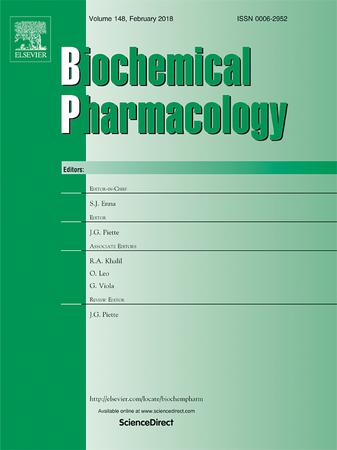Integrative CYP450 and network pharmacology approach for the assessment of Corilagin’s influence on Sitagliptin pharmacokinetics
IF 5.3
2区 医学
Q1 PHARMACOLOGY & PHARMACY
引用次数: 0
Abstract
Type 2 diabetes (T2D) is a complex metabolic disorder marked by elevated blood glucose levels and a high risk of cardiovascular complications. Sitagliptin (SIT), a widely prescribed Dipeptidyl Peptidase-4 (DPP-4) inhibitor, is commonly used for T2D and undergoes extensive metabolism primarily via CYP3A4. Corilagin (COR), a bioactive ellagitannin known for its antioxidant, anti-inflammatory, and anti-diabetic properties, is frequently used in traditional medicine but is not well-studied for its CYP450 metabolism. This study employed a network pharmacology and pharmacokinetics approach to evaluate COR’s influence on SIT. A total of 45 overlapping anti-diabetic gene targets were identified, and pathway enrichment analysis highlighted insulin resistance, lipid metabolism, and HIF-1 signalling, among others, as potential therapeutic intersections. CYP3A4 and CYP2C8 inhibition assays showed IC50 values of 2.815 µM and 0.645 µM for SIT, 4.277 µM and 0.470 µM for COR, and 3.999 µM and 0.389 µM for their combination, respectively. CYP3A4 inhibition assays showed IC50 values of 2.815 µM for SIT, 4.277 µM for COR, and 3.999 µM for their combination, indicating COR’s influence on SIT metabolism. These findings suggest that COR may alter SIT’s pharmacokinetic profile via CYP3A4 modulation, warranting caution in their combined use to maintain therapeutic efficacy. A sensitive LC-MS-QTOF method was developed to quantify SIT and COR in rat plasma concurrently. Pharmacokinetic analysis revealed that COR co-administration significantly reduced SIT’s bioavailability, decreasing Cmax by 5.8-fold and AUC by 14.96-fold and prolonging t1/2 by increasing 1.52-fold. This integrated approach provides insight into herb-drug interactions in diabetes treatment, emphasizing the need for tailored dosing strategies in clinical applications.

综合CYP450和网络药理学方法评估科里拉金对西格列汀药代动力学的影响
2型糖尿病(T2D)是一种复杂的代谢紊乱,其特征是血糖水平升高和心血管并发症的高风险。西格列汀(SIT)是一种广泛使用的二肽基肽酶-4 (DPP-4)抑制剂,通常用于T2D,主要通过CYP3A4进行广泛的代谢。鞣花金(COR)是一种生物活性鞣花单宁,以其抗氧化、抗炎和抗糖尿病特性而闻名,在传统医学中经常使用,但其CYP450代谢尚未得到充分研究。本研究采用网络药理学和药代动力学方法评估COR对SIT的影响。共鉴定了45个重叠的抗糖尿病基因靶点,途径富集分析突出了胰岛素抵抗、脂质代谢和HIF-1信号传导等潜在的治疗交叉点。CYP3A4和CYP2C8对SIT的IC50分别为2.815µM和0.645µM, COR的IC50分别为4.277µM和0.470µM,两者联合的IC50分别为3.999µM和0.389µM。CYP3A4抑制实验显示,SIT的IC50值为2.815µM, COR的IC50值为4.277µM,二者联合的IC50值为3.999µM,表明COR对SIT代谢有影响。这些发现表明,COR可能通过CYP3A4调节改变SIT的药代动力学特征,因此在联合使用以保持治疗效果时要谨慎。建立了同时定量大鼠血浆中SIT和COR的LC-MS-QTOF方法。药代动力学分析显示,与COR共给药显著降低了SIT的生物利用度,Cmax降低5.8倍,AUC降低14.96倍,t1/2延长1.52倍。这种综合方法提供了对糖尿病治疗中草药药物相互作用的见解,强调了在临床应用中定制剂量策略的必要性。
本文章由计算机程序翻译,如有差异,请以英文原文为准。
求助全文
约1分钟内获得全文
求助全文
来源期刊

Biochemical pharmacology
医学-药学
CiteScore
10.30
自引率
1.70%
发文量
420
审稿时长
17 days
期刊介绍:
Biochemical Pharmacology publishes original research findings, Commentaries and review articles related to the elucidation of cellular and tissue function(s) at the biochemical and molecular levels, the modification of cellular phenotype(s) by genetic, transcriptional/translational or drug/compound-induced modifications, as well as the pharmacodynamics and pharmacokinetics of xenobiotics and drugs, the latter including both small molecules and biologics.
The journal''s target audience includes scientists engaged in the identification and study of the mechanisms of action of xenobiotics, biologics and drugs and in the drug discovery and development process.
All areas of cellular biology and cellular, tissue/organ and whole animal pharmacology fall within the scope of the journal. Drug classes covered include anti-infectives, anti-inflammatory agents, chemotherapeutics, cardiovascular, endocrinological, immunological, metabolic, neurological and psychiatric drugs, as well as research on drug metabolism and kinetics. While medicinal chemistry is a topic of complimentary interest, manuscripts in this area must contain sufficient biological data to characterize pharmacologically the compounds reported. Submissions describing work focused predominately on chemical synthesis and molecular modeling will not be considered for review.
While particular emphasis is placed on reporting the results of molecular and biochemical studies, research involving the use of tissue and animal models of human pathophysiology and toxicology is of interest to the extent that it helps define drug mechanisms of action, safety and efficacy.
 求助内容:
求助内容: 应助结果提醒方式:
应助结果提醒方式:


